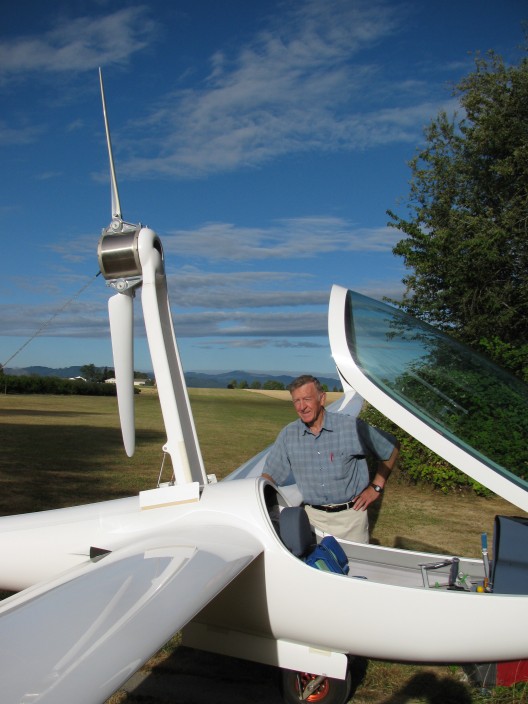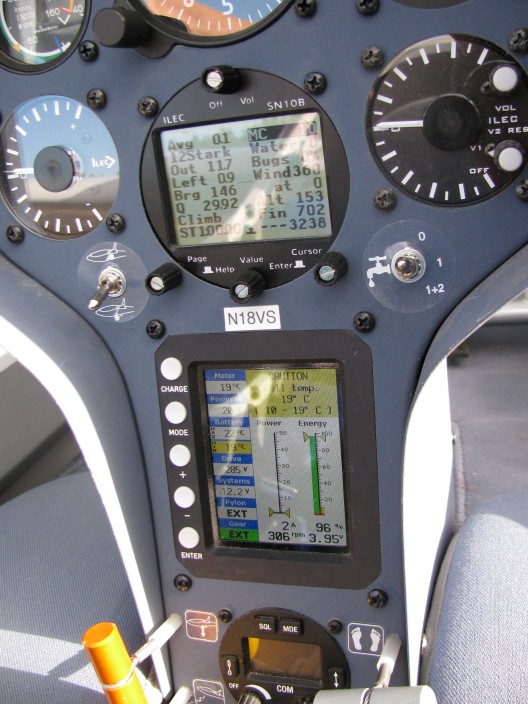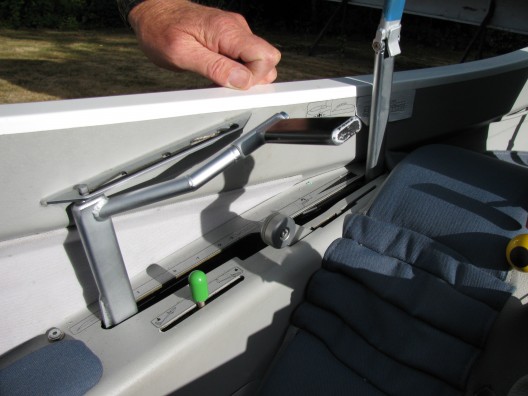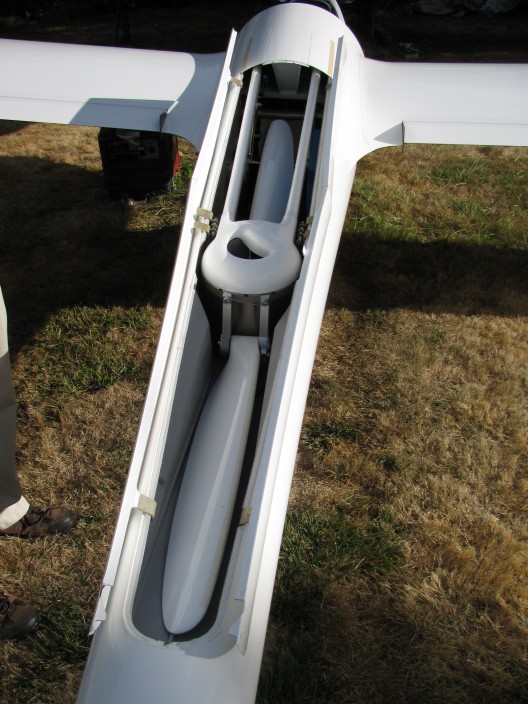In a visit to Richard Van Grunsven’s airport home, just across the Sunset Highway from North Plains, Oregon, this blogger was privileged to get a closeup view of his Antares 20E, an electric self-launching sailplane from Germany’s Lange Aviation. Spanning 20 meters (65.6 feet), the gleaming white ship has fluidity of line and integrity of design one would expect from Gerhard Waibel (the “W” in Alexander Schleicher’s ASW sailplanes).
The outstanding feature that sets this particular long-span craft apart is its 42 kilowatt (57 horsepower) motor, snugged neatly into a bay behind the pilot, and raised on a carbon-fiber mast by a smooth electric/hydraulic mechanism. A cylindrical unit, the motor’s outer shell rotates about a stationary hub attached to the mast. Two carbon-fiber propeller blades attach to beautifully machined fittings on the rotating cylinder, and provide enough thrust to give the 460 kilogram (1,014 pound) ship a 4.4 meter per second (866 feet per minute) rate of climb at its 66o kilogram (1,455 pound) maximum loaded weight. SAFT batteries tucked in the wing roots store enough energy for about 3,000 meters (9,850 feet) of total climb, slightly over 11 minutes at full power.
Dick, as he likes to be called, rarely uses the total energy available, keeping some on tap for “saves” in down air or for a final glide assist (something he takes pains to avoid). His overall low use of power is remarkable; one display indicates over 400 flight hours and only 14 hours of motor use. He explains that it isn’t quite a fair ratio, since he makes it a point to use local tow planes for soaring competitions, not logging several hours of what would have been motorized launches. The factory lists the time between overhauls for the motor at 900 hours. Dick’s Antares could fly 65 years before its first “major.” All electrical components are attached to the non-moving part of the motor. Only four parts, two ball bearings and two sealing rings, are subject to wear. The factory notes that, “Maintenance consists of exchanging the two sealing rings and it must be performed every 200 hours of motor time or every 10 years, whichever happens first.” Antares’ motor turns 1,500 rpm in normal use, with a flat torque line all the way from near rest to 1,600 rpm.
Batteries, because of the limited necessity for running the motor, should last an equally impressive time. Lange predicts 3,000 cycles for the batteries before their energy storage capabilities reach 80-percent of original capacity, providing over 4 million meters of climb, or 13,615,000 feet, before needing replacement. That would be over 4,500 launches to 3,000 feet, or about $135,000 in tow fees at $30 per tow.
Dick demonstrates the small displays that keep track of battery charge and all elements of the airplane’s “health,” motor and flight operations Their multiple modes of operation provide computerized checklists, an electric variometer, GPS, and a flight calculator that not only provides the altitude required to reach a goal, but the total altitude required to fly around a series of turnpoints on the way to that goal. The system can even be accessed remotely, so that a pilot could check the airplane’s status while at a Wi-Fi coffee bar.
Dick shows off the three-position spoilers near the center of each wing panel. At the lowest open position, Antares’ 56:1 glide ratio drops to that of a Schweitzer 1-26, about 26:1. At their greatest extension, the speed brakes drop the glide to a 6:1 hang-glider-like descent. Dick actuates the flaperon lever that moves the aileron/flap linkages to a reflexed camber for high-speed runs, and drops them to their landing configuration. All this provides for highly-maneuverable action, and the ability to “core” tight thermals.
Finally, Dick starts the motor extension and startup sequence. Aside from the impressively-crafted motor and 2-meter (6.56 feet) propeller elevating above us, nothing much happens, other than the disembodied voice of Martina (a real person at the Lange works, Dick says) announcing the various stages of motor startup. Martina’s rich tones also provide alerts for matters of concern. This is all done simply, with a single round gray lever on the left side of the cockpit. Moving the lever to its first position raises the motor; pushing it further forward starts the motor and revs it to its 1,500 rpm. Pulling the lever back reduces motor speed; pulling it all the way back to its rest position slows and finally stops the motor and retracts the elegant power stalk. Any electrical/electronic motor control magic is thoroughly transparent to the pilot.
As Dick notes, the simplicity of operation and the reliability of the system virtually eliminate a prime cause of accidents in retractable motor gliders, power failure followed by a difficult restart attempt while either on takeoff or after reaching too low an altitude to glide to safety.
The motor sounds a bit industrial in winding up to its top speed, but noise levels are nowhere near those of a two-stroke engine in the same application. The large, slow-turning propeller also helps make the Antares a good neighbor.
After several run-ups, Dick retracts the motor for the last time, noting that the beautifully machined propeller hub fittings allow the propeller blades to fold upward as the motor pushes down to its storage point in the slim rear fuselage.
As he pushes the gleaming ship back into its carport-like hangar Dick notes that Dave Nadler, North American distributor for the Antares, and he are involved in an on-line soaring competition, posting results of sometimes daily flights to gain total points in a world-wide comparison of skills and luck. Dick apologizes for his lack of extremely long flights, but Nadler, in an email earlier this year, would disagree.
“Dick is always too modest. Lest you think I’m the only one flying long distances in An Antares 20E, here’s a recent flight Dick made.”
Dave also shows a level of modesty. “I’ve only had one really good flight this year. 2 minutes of motor time, 7:20 total time, and 440 miles distance covered. See the google maps presentation.”
“The time from starting takeoff roll to finishing engine retraction (which takes ~12 seconds) was 2:14, and shutdown was at 1,200 ft AGL. The peak climb rate is in excess of 800fpm. It was a windy day (>20 knots at altitude) so the Cub would have had a tough time! (Your editor had compared the flight to that of a Piper Cub undertaking the same route.) Note I only spent 15% of the time circling; mostly I flew straight following energy lines.”
Dick Van Grunsven has already carved a niche for himself in aviation history, selling thousands of kits for everything from single-seat to four-seat aircraft. Almost 7,000 RVs are now flying, making Dick one of the major suppliers of light aircraft. Part of the reason for his success is his scrupulous adherence to honest performance reporting, backed up by the CAFE Foundation’s testing of his craft over the years.
In that vein, he describes some issues with the beautiful Antares in the most recent online issue of the RV-Ator, his corporate newsletter.
“It would seem that the batteries need to be ‘rested’ periodically to re-balance themselves, either by shutting them off or operating them at a much lower continuous power draw like the ‘low cruise’ mode.” This might be of concern in a “save” situation. He also explains that part of the batteries’ energy is required to heat themselves for proper operation, and that the motor should not be operated at full power if battery temperature is below 20 degrees C (68 degrees F).
“The bottom line is that, from my experience, electric aircraft operation is not necessarily as ‘plug-and-play’ as some advocates would like you to believe. In some respects, it is. For instance, operating the motor is as simple as pushing a lever forward – the equivalent of ignition, primer, starter, throttle, mixture control, etc., all in one operation. On the other hand, there are concerns such as the limited energy (range) available, and the battery temperature issue. We can continue to hope for breakthroughs to alleviate these concerns, but in reality we probably must not expect more than incremental gains in the near future.”





Comments 2
The future is electrizing, indeed!
Galvão
75
Pingback: Antares Upgrades to RED.3 Batteries - Sustainable Skies